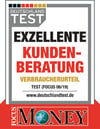The longer the current pandemic lasts, the more contradictory the statements regarding the future of automotive logistics become. On one hand, one could be very confident: Precedence Research, for example, assumes in its October 2020 report that the global automotive logistics market will grow by 5.6% annually until 2027. On the other hand, the recently published Allianz Risk Barometer speaks of a "COVID trio" of business interruption, pandemics, and cyber attacks. In particular, business interruptions, i.e. supply chain problems, are again at the top of the list of possible risks in 2021.
The question now is: Will things continue as before or will everything be different in the future?So, does the future appear "rosy" or will it live according to the motto of "becoming even more critical in the automotive supply chain"? The apparent contradiction that can be seen here is typical of the VUCA world (Volatility, Uncertainty, Complexity, and Ambiguity), which already influenced the automotive industry pre-COVID. Therefore, the question cannot be answered unambiguously in one direction or the other because some supply chain challenges remain, while others are newly added in the wake of the pandemic. In the following, we will look at three selected aspects that will also apply in the future and three examples that are leading or have led to a rethink.
Business as usual!
1. Supply Chain Visibility
There is hardly any other industry in which the supply chain is structured as complexly as the automotive industry. When a new car with a classic powertrain consists of several thousand parts and a Tier 1 supplier like Bosch has over 26,500 suppliers in 52 countries, this clearly shows the importance of transparency in the supply chain. Fifteen years ago, "visibility" was still something of a visionary abstract, but today there are tools, such as Lila Logistik’s Control Tower, which not only guarantee an overview of the supply chain as a dashboard in real time, but also aids in planning, control and monitoring across all modes of transport. After all, transparency in itself is not a value but merely the basis for making the right logistical decisions.
2. China – No. 1 Automotive World Market in Asian century
At the beginning of 2020, there were experts who predicted that the pandemic dubbed the "China virus" would bring an end to the growth engine and largest sales market for new vehicles. In the end, the decline was rather moderate at six percent to a good 20 million new passenger cars, compared with minus 19 percent in Germany in 2020. Even if the Chinese market could stagnate at a high level, it will gain in relative importance as a procurement, production and sales market. On the one hand, this is a positive sign for supply chain managers to compensate for declines in other regions; on the other hand, new regulations and trade barriers, for example between China and the USA, complicate global trade.
3. Operational Excellence
Despite differentiated supply chain risk management, risks that cannot be predicted will increasingly arise in the future. This requires both resilient supply chains and operational excellence, which ensures that the respective link in the supply chain acts economically even in very difficult conditions. Introduced in the course of lean management initiatives in many companies, it must be ensured, especially in times of COVID-19, that "lean" is not confused with "anorexic" in the resource planning of personnel and facilities.
A different future!
1. Inventory management: Intelligent bottleneck orientation
In contrast to "Operational Excellence" as part of the Toyota Production System, the mantra of "inventories must go down" no longer applies without restriction in COVID and post-COVID times. Particularly in the automotive environment, it is apparent that earlier targets such as an inventory range of less than one day, a quite common target at numerous OEM assembly plants, can now be classified as too ambitious (i.e., outdated). However, Corona has shown that inventory management should not be equated with inventory reduction. Rather, bottleneck suppliers and materials must be identified along the supply chain, and, in the next step, inventories must be built up there in a targeted manner. The current shortage of semiconductors, particularly from Asia, which led to production stops and short time working at Daimler, VW, Audi, and Ford in January and February, shows that even well-known OEMs are no exception to such bottlenecks.
2. Glocal: The new global
While there are hardly any options for regional or even local procurement in the case of semiconductors, a rethink of the usual "global sourcing" procurement strategy is more advisable for other procurement sources. As with just-in-time and just-in-sequence in logistics, global sourcing should not be the only purchasing strategy pursued. The trend towards "glocal" certainly will not lead to a situation in which everything is procured "around the church tower" in the future for reasons of risk. However, if one is seriously looking for the most favorable procurement source and not the lowest parts price, TCO models should seriously calculate potential business interruptions and factor them into the selection of the best supplier. Classic bonus systems, which are based solely on the material cost savings of the purchaser, then lead to misguided decisions and the ultimately more expensive choice of supplier. The distortions in the supply chain are therefore a good reason to rethink current procurement strategies.
3. Logistics Challenge: E-Mobility
The trend toward electric vehicles not only requires a rethink in the R&D departments of car manufacturers or among potential customers and society, but also leads to new requirements in transport and storage logistics: This starts with increasingly heavy finished goods as hybrids or full-power vehicles that have to be transported from A to B and does not end with the adequate storage of HV batteries. This increases the logistical demands on storage and transport goods, such as the installation of charging stations at vehicle logistics companies or new safety precautions. On the other hand, electric vehicles have far fewer components, which in turn leads to a simplification of the supply chain. For example, BMW General Works Council Chairman Manfred Schoch noted back in 2017, "An eight-cylinder engine has 1,200 parts that need to be assembled, an electric motor, only 17 parts." From the logistics service provider's point of view, free capacities here must be utilized differently in the medium term. Finally, new challenges also arise at the end of the battery life cycle, which will lead to new business models in automotive redistribution logistics (sorting, processing, recovery, etc.).
Conclusion: A clear both/and!
The global automotive industry is not only undergoing a cyclical upheaval, as it did in 2009, but also a structurally disruptive one affecting all links in the supply chain. This gives rise to opportunities as well as risks. Regardless of how one assesses the situation for one's own company or corporate environment, the realization remains that the relevance of effective and efficient supply chain management, even after COVID-19, will continue to increase. Martin Christopher, a Professor Emeritus of Marketing and Logistics in the UK, came to the conclusion almost 30 years ago: "Supply chains compete, not companies.“

Prof. Dr. Dirk H. Hartel, born in 1972 in Eschwege/North Hesse, has been working as a professor for logistics and supply chain management at the Baden-Württemberg Cooperative State University in Stuttgart since 2007, where he is head of the business administration service management course. Dirk Hartel first completed a dual study programme in cooperation with Siemens Nixdorf and studied business administration parallel to working for Siemens in regional marketing at the University of Lüneburg. From 1998 to 2002 he did his doctorate under Professor Wildemann at the Technical University of Munich. He then worked for several years as a consultant for supply chain management, logistics and organisation at a medium-sized consultancy in Munich, and has been a partner since 2006. Dr Hartel teaches at private universities and colleges and works part-time as a consultant, speaker and trainer.
Publications in the fields of logistics, supply chain management, supply chain risk management, outsourcing and consulting, e.g. books on "Consulting and Project Management in Industrial Companies" (2009), "Case Studies in Logistics" (2012), "Consultant Etiquette" (2013), "Logistics and Supply Chain Management - A German-Indian Comparison" (2017) and "Project Management in Logistics and Supply Chain Management" (2019).








